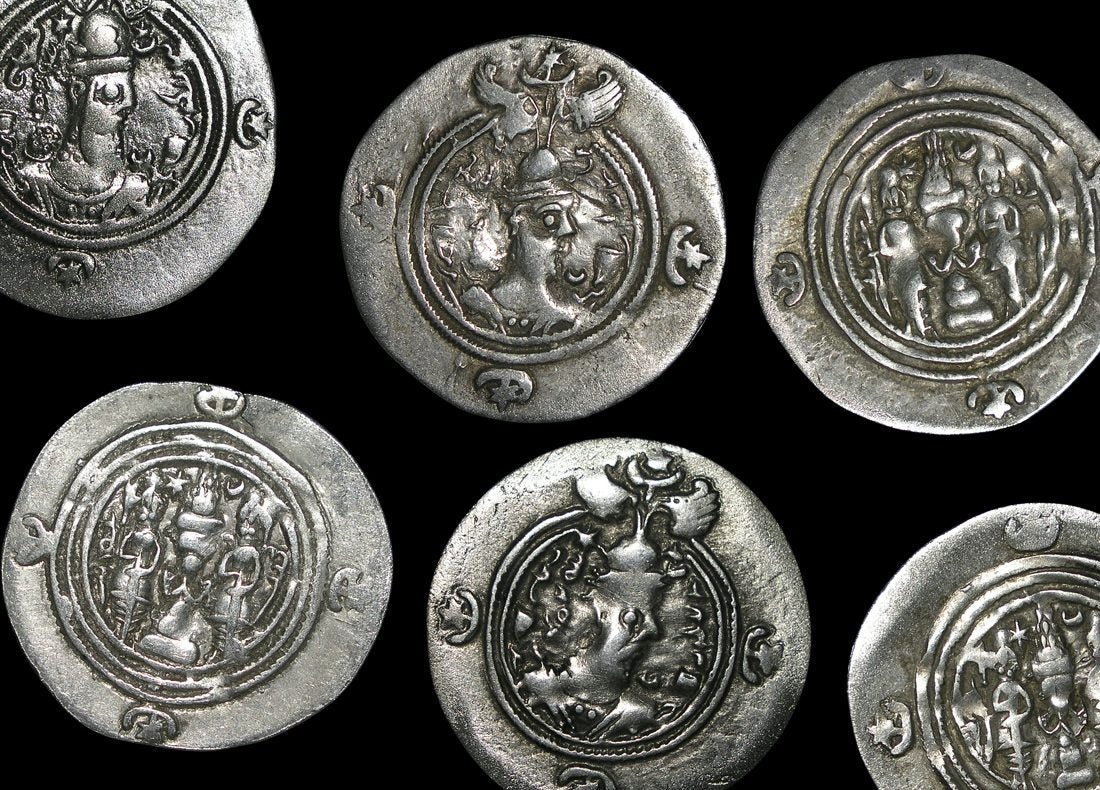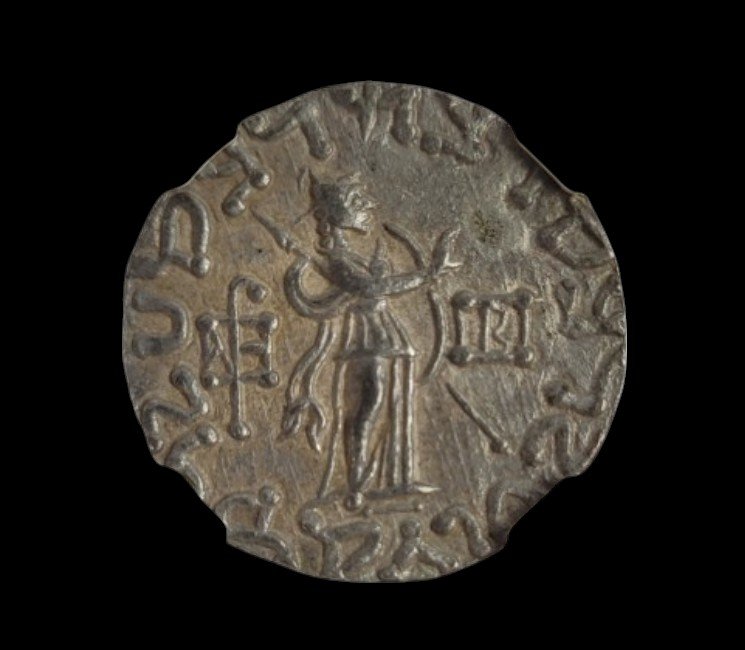 Image 1 of 2
Image 1 of 2

 Image 2 of 2
Image 2 of 2



Silver Siglos from the First Persian Empire (about 2,470-2,520 years ago)
This silver coin, known as a siglos, was used throughout the Achaemenid Persian Empire during the fifth century BCE. As the first standardized currency of the Persian Empire, these coins facilitated trade across one of history's largest empires, stretching from Egypt and the Balkans to the Indus Valley.
Coin Description:
Front side: Depicts a hero-king figure (possibly Darius I) in a half-kneeling position, armed with a bow and dagger
Back side: Features an irregular incuse punch mark (a rectangular depression in the metal)
Technical Details:
Silver composition
Siglos denomination (1/20th of a gold daric)
NGC certified and slabbed (Numismatic Guaranty Company authentication)
Minted circa 500-450 BCE
Condition as noted in NGC slab
Historical Significance:
This coin circulated during the height of the Achaemenid Empire (First Persian Empire), one of antiquity's most influential civilizations. Founded by Cyrus the Great and expanded by rulers like Darius I and Xerxes I, the empire was known for its sophisticated administration, road networks, and religious tolerance. The fifth century BCE was particularly momentous as it featured famous conflicts between Persia and the Greek city-states, including the Battle of Marathon (490 BCE) and Thermopylae (480 BCE). The siglos was part of the world's first truly international monetary system, with the design intentionally simple to facilitate acceptance across diverse cultures within the vast empire. The hero-king imagery represented Persian royal power and divine authority, helping to unify the empire's visual identity across its extensive territories.
This silver coin, known as a siglos, was used throughout the Achaemenid Persian Empire during the fifth century BCE. As the first standardized currency of the Persian Empire, these coins facilitated trade across one of history's largest empires, stretching from Egypt and the Balkans to the Indus Valley.
Coin Description:
Front side: Depicts a hero-king figure (possibly Darius I) in a half-kneeling position, armed with a bow and dagger
Back side: Features an irregular incuse punch mark (a rectangular depression in the metal)
Technical Details:
Silver composition
Siglos denomination (1/20th of a gold daric)
NGC certified and slabbed (Numismatic Guaranty Company authentication)
Minted circa 500-450 BCE
Condition as noted in NGC slab
Historical Significance:
This coin circulated during the height of the Achaemenid Empire (First Persian Empire), one of antiquity's most influential civilizations. Founded by Cyrus the Great and expanded by rulers like Darius I and Xerxes I, the empire was known for its sophisticated administration, road networks, and religious tolerance. The fifth century BCE was particularly momentous as it featured famous conflicts between Persia and the Greek city-states, including the Battle of Marathon (490 BCE) and Thermopylae (480 BCE). The siglos was part of the world's first truly international monetary system, with the design intentionally simple to facilitate acceptance across diverse cultures within the vast empire. The hero-king imagery represented Persian royal power and divine authority, helping to unify the empire's visual identity across its extensive territories.
This silver coin, known as a siglos, was used throughout the Achaemenid Persian Empire during the fifth century BCE. As the first standardized currency of the Persian Empire, these coins facilitated trade across one of history's largest empires, stretching from Egypt and the Balkans to the Indus Valley.
Coin Description:
Front side: Depicts a hero-king figure (possibly Darius I) in a half-kneeling position, armed with a bow and dagger
Back side: Features an irregular incuse punch mark (a rectangular depression in the metal)
Technical Details:
Silver composition
Siglos denomination (1/20th of a gold daric)
NGC certified and slabbed (Numismatic Guaranty Company authentication)
Minted circa 500-450 BCE
Condition as noted in NGC slab
Historical Significance:
This coin circulated during the height of the Achaemenid Empire (First Persian Empire), one of antiquity's most influential civilizations. Founded by Cyrus the Great and expanded by rulers like Darius I and Xerxes I, the empire was known for its sophisticated administration, road networks, and religious tolerance. The fifth century BCE was particularly momentous as it featured famous conflicts between Persia and the Greek city-states, including the Battle of Marathon (490 BCE) and Thermopylae (480 BCE). The siglos was part of the world's first truly international monetary system, with the design intentionally simple to facilitate acceptance across diverse cultures within the vast empire. The hero-king imagery represented Persian royal power and divine authority, helping to unify the empire's visual identity across its extensive territories.
The Achaemenid Empire or Achaemenian Empire,[16] also known as the Persian Empire[16] or First Persian Empire[17] (/əˈkiːmənɪd/; Old Persian: 𐎧𐏁𐏂, Xšāça, lit. 'The Empire'[18] or 'The Kingdom'[19]), was an Iranian empire founded by Cyrus the Great of the Achaemenid dynasty in 550 BC. Based in modern-day Iran, it was the largest empire by that point in history, spanning a total of 5.5 million square kilometres (2.1 million square miles). The empire spanned from the Balkans and Egypt in the west, most of West Asia, the majority of Central Asia to the northeast, and the Indus Valley to the southeast.[12][13]
Around the 7th century BC, the region of Persis in the southwestern portion of the Iranian plateau was settled by the Persians.[20] From Persis, Cyrus rose and defeated the Median Empire as well as Lydia and the Neo-Babylonian Empire, marking the establishment of a new imperial polity under the Achaemenid dynasty.
You Might Also Like













